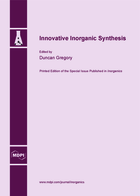Innovative Inorganic Synthesis
A special issue of Inorganics (ISSN 2304-6740).
Deadline for manuscript submissions: closed (15 November 2013) | Viewed by 81090
Special Issue Editor
Interests: nitrides; chalcogenides; carbides; hydrides; synthesis; structure; solid-state chemistry; materials chemistry
Special Issues, Collections and Topics in MDPI journals
Special Issue Information
Dear colleagues,
The synthesis of inorganic compounds embraces an immense range of techniques and approaches. New organometallic molecules, for example, might demand multi-step organic reactions in the successful production of ligands followed by precision handling and manipulation to form the desired complexes under anaerobic conditions. By contrast, preparation of solid state compounds can demand extreme conditions of temperature and pressure to overcome the formidable thermodynamic and kinetic barriers to their formation. It is the target of many inorganic chemists, both by experiment and computation, to prepare or predict new compounds and materials, to discover the most appropriate conditions under which such substances can be made and to design the experiments that will realise them. New inorganic compounds remain attractive, for example, for their inherent complexity and beauty, for their chemical behaviour, their chemical or biological activity or for their physical properties.
The need and desire for new compounds often demands increasingly sophisticated and imaginative synthesis strategies. Equally, the modern societal pressures of cost, safety and environmental protection require new attitudes to the synthesis of high value chemical products. Time and energy efficiency, use of earth-abundant resources and many other green chemistry principles become key parameters in the design of new synthetic processes. I would like to dedicate this inaugural issue of “Inorganics” therefore, to the concept of “innovative synthesis” – from the intricacy of constructing extended molecular solids on the basis of weak supramolecular forces through the appealing simplicity of “one-pot” methods to make cluster and hybrid materials and soft chemical means to produce solid state materials to the adaptation of inefficient lab techniques towards streamlined flow processes for the preparation of fine chemicals. This special issue invites contributions in all of the above areas and beyond; the primary requisite being the application of creative approaches to achieve synthetic goals.
Prof. Duncan H. Gregory
Guest Editor.
Manuscript Submission Information
Manuscripts should be submitted online at www.mdpi.com by registering and logging in to this website. Once you are registered, click here to go to the submission form. Manuscripts can be submitted until the deadline. All submissions that pass pre-check are peer-reviewed. Accepted papers will be published continuously in the journal (as soon as accepted) and will be listed together on the special issue website. Research articles, review articles as well as short communications are invited. For planned papers, a title and short abstract (about 100 words) can be sent to the Editorial Office for announcement on this website.
Submitted manuscripts should not have been published previously, nor be under consideration for publication elsewhere (except conference proceedings papers). All manuscripts are thoroughly refereed through a single-blind peer-review process. A guide for authors and other relevant information for submission of manuscripts is available on the Instructions for Authors page. Inorganics is an international peer-reviewed open access monthly journal published by MDPI.
Please visit the Instructions for Authors page before submitting a manuscript. The Article Processing Charge (APC) for publication in this open access journal is 2700 CHF (Swiss Francs). Submitted papers should be well formatted and use good English. Authors may use MDPI's English editing service prior to publication or during author revisions.






